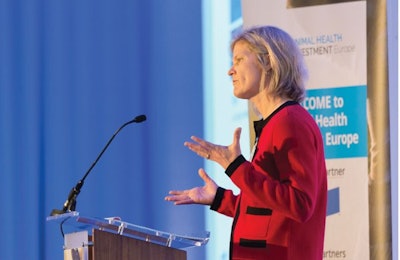
The relationships between poultry producers, veterinarians and animal health companies can be expected to alter significantly over the years ahead as, like animal protein production, veterinary practices and veterinary medicine companies undergo significant change.
New technologies and advances in science may mean that poultry producers will be able to expect more from veterinarians, while concerns over welfare and antibiotic resistance may alter on-farm practices. Changing attitudes to careers and work/life balance among younger generations may affect how services are sought and delivered.
Innovation in working practices will be accompanied by the products and services offered by animal health companies, which are looking at working in new ways to help boost livestock producers’ output.
Despite ongoing changes to how flock and herd health is managed, there remains significant room for improvement, delegates at Animal Health Investment Europe were told, particularly because 20 percent of livestock production is still lost to death and disease.
Need for closer collaboration
According to Kristin Bloink, global research and external innovation with Elanco Animal Health, all players in the animal food production chain need to work together to ensure animal production is ethical, has high standards of care, and uses antibiotics responsibly. Where animal welfare is concerned, it is a key element for success in food animal production systems, which relies on achieving a balance between welfare, productivity and market access.
To help achieve these goals while raising productivity, animal health companies are looking at new ways of innovating, she said, and bringing new products and services to the farm is drawing on three main resources: new technologies, closer collaborations and the One Health Initiative.
How companies innovate is changing, according to Randolph Seidler, vice president, global head of business development with Boehringer Ingelheim. Ten years ago, veterinary medicine companies were simply looking for new molecules; now they are offering integrated solutions, including information management – anything that makes customers’ lives easier.
Innovation leads to differentiated offerings and this leads to value. For example, monetarily smaller services are now being offered if they bring value to the client.
Dr. Tim Schell, nutritional health R&D and regulatory with Elanco Animal Health, noted that, while constant challenges remain in the livestock sector, for example, that nine out of 10 chickens are still exposed to coccidiosis, advances in science mean that new solutions are becoming more likely. It has now become easier to demonstrate the benefits of new approaches, meaning that potential solutions that may have been dismissed only a decade ago are now being taken more seriously.
Change, however, is not only taking place within the veterinary medicines industry; significant changes are also taking place within the veterinary profession.
Evolving attitudes
Ownership of veterinary practices in some countries is undergoing a significant change with many veterinarians no longer wanting to own their own practice, with the consequent responsibilities of running a business.
Practices are coming under the ownership of corporations, with implications for service offerings and working practices.
This is not the only area of change at the veterinary level and, in some countries, there is a significant shortage of veterinarians. In the U.K., for example, only 3 out of 10 work full time and, among those that do work full time, many would like to reduce their hours.
A desire for a greater work/life balance has resulted in many veterinarians coming under greater time pressure during the hours that they work, and this affects how they interact with livestock and livestock owners, as well as with animal health companies.
The veterinary profession is also evolving in other ways. For example, in 1970, in the U.S., 11 percent of veterinary graduates were female, while in the U.K. this figure was 16 percent. By 2013, 80 percent of veterinary graduates in the U.S. were female, while in the U.K. the figure has risen to 77 percent.
Working hours and the feminization of the industry are not the only changes.

How veterinarians interact with livestock producers will increasingly change, not only as new technologies come to market, but also as working patterns shift. | budabar, Bigstock.com
According to Gudrun Ravetz, senior vice president of the British Veterinary Association, demands on time are resulting in veterinarians increasingly preferring to be contacted via mobile, rather than engaging in face-to-face meetings. Within the younger veterinary profession, corporate social responsibility and One Health have become highly important and, if companies are not able to clearly demonstrate their commitment to these areas, it may be increasingly difficult to engage with the profession.
The future of poultry health: New and old challenges
















